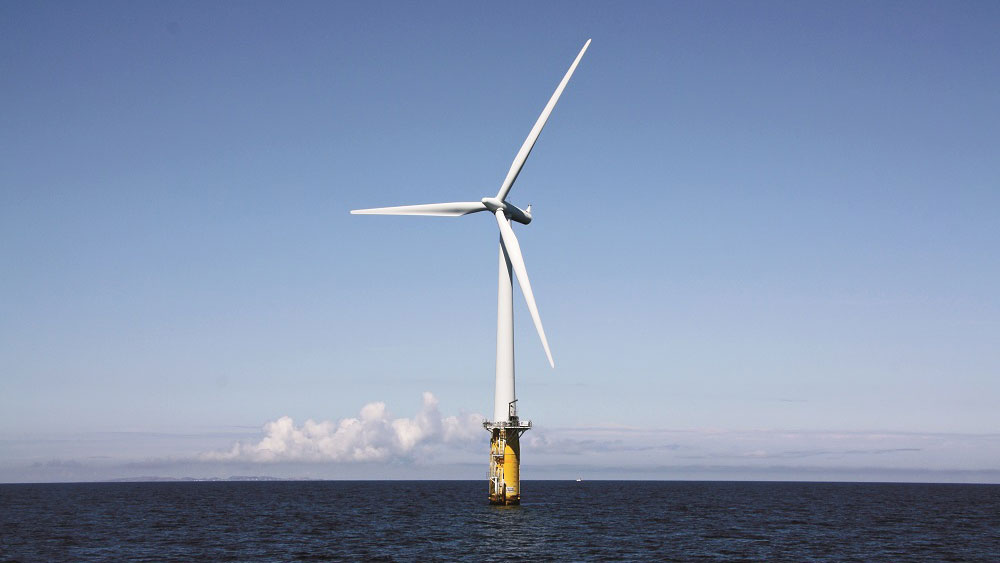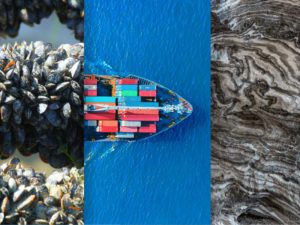
Floating offshore wind turbine. Photo: Senu Sirnivas / NREL
From unprecedented support for offshore wind at the federal level to active discussions at the state level, California may be poised to start the roughly decade-long process to bring its first offshore wind farms online—and has the potential to become the largest offshore wind market in the United States. Our Shared Seas checked in with Molly Croll, Director, Offshore Wind Program at American Clean Power-CA, to understand the policy state of play, potential scenarios for offshore wind development in California, and opportunities for philanthropy and civil society to support responsible development, while minimizing impacts on marine species and habitats.
California is poised to be a global leader on offshore wind development and appears to have a window of opportunity to bring the industry to scale. Do you think that 2021 will be the year of offshore wind in California that jump-starts the sector’s growth?

An engineering team constructs a scale model turbine to be tested. Photo: William Drake Photography
Absolutely. There’s a few reasons why 2021 is the year of offshore wind in California. To start, it’s the first time that the state has considered offshore wind as an essential part of its energy mix for the next two decades. This year, California finalized the Senate Bill (SB) 100 Joint Energy Agency Report which looked at how we will achieve a carbon-free electric system by 2045, which is what SB 100 requires as law. This report showed that we must quickly ramp up new renewable and energy storage resources, including at least 10 gigawatts of offshore wind as part of the lowest-cost portfolio.
Second, the political moment with the Biden-Harris administration is critical. The president has long been a proponent of wind, and he doubled down on that commitment with his recent announcement to double U.S. offshore wind capacity by 2030 and boost transmission. This is an ambitious goal and it’s a call to action for California. This is an invitation and an opportunity for California to answer this call and step into leadership. And importantly, it’s an opportunity for the state to sign up for a piece of federal attention and funding associated with this goal.
[The federal offshore wind target] is an invitation and an opportunity for California to answer this call and step into leadership. And importantly, it’s an opportunity for the state to sign up for a piece of federal attention and funding associated with this goal.
Third, we have the right partners lined up. We have a supportive Congress right now, and there is a strong coalition in California between the offshore wind industry, NGOs, labor, and environmental justice organizations. We’ve seen that this kind of coalition has been critical in advancing offshore wind on the East Coast.
On the other hand, there are consequences if we do not scale up offshore wind in 2021. If we fail to advance offshore wind this year, California may turn to other resources to fill in its energy portfolio. These sources may be more expensive, less reliable, or keep us locked into fossil fuels for a longer time period. These are real risks and outcomes of not acting on offshore wind right now.
Stepping back, we know that there are currently no contracts or leases for offshore wind in California. Why is this the case?
There are a few reasons why offshore wind has not developed in California to date. First, the state will require floating offshore wind. This is a newer technology that is about 10 years behind fixed-bottom platforms. Second, California has progressed more slowly than U.S. East Coast states, Europe, Japan, and South Korea in realizing that offshore wind must be an essential part of the portfolio in our decarbonization plan. So far, California has benefited from its vast access to land-based energy sources, which are less available in places like the East Coast, which have turned to the ocean more quickly for clean energy.
Why is offshore wind necessary to supplement terrestrial sources of renewable energy to meet California’s clean energy targets? Could the state meet its targets without the use of offshore wind?
An important takeaway from SB 100 is the sheer quantity of renewables and storage that we must build. California currently has 12.5 gigawatts of utility-scale solar, six gigawatts of wind, and about three gigawatts of geothermal. By 2045, the state needs about 145 gigawatts combined of renewables and energy storage. This means increasing the build rate to install six gigawatts of new renewables and battery storage every year for the next 25 years. That’s a huge leap! This far exceeds even the “renewable energy boom period” in California during the American Recovery and Reinvestment Act of 2009. To meet SB 100, offshore wind must be in the mix.
Another key consideration is that the land use implications are significant. A part of SB 100, The Nature Conservancy and Defenders of Wildlife prepared a “back of the envelope” calculation and found that California would need to build on the order of 36,500 acres of wind and 22,100 acres of solar every year for the next 25 years. This is a lot of land! If we want to protect sensitive species and habitat on land, it’s better to have a more diverse and wider geographic area to tap for clean energy, which means looking to the ocean. For this reason, integrating offshore wind as part of the solution set is vital from a broader conservation perspective.
If we want to protect sensitive species and habitat on land, it’s better to have a more diverse and wider geographic area to tap for clean energy, which means looking to the ocean. Integrating offshore wind as part of the solution set is vital from a broader conservation perspective.
Offshore wind projects on the East Coast provide over a decade of learning and experimentation. What can stakeholders in California learn from these experiences on the East Coast?

Block Island Wind Farm. Photo: Dennis Schroeder / NREL
There are several valuable lessons from the East Coast. First, state goal setting and planning has been the single most important driver in offshore wind in East Coast states. The sweet spot is having a clean energy target at the state level, the governor’s backing, and a strong stakeholder coalition.
For the environmental community and conservation funders, we can look to the East Coast for good examples of how eNGOs and developers have come together in support for responsibly built offshore wind. We should replicate this on the West Coast.
Some of the successes from the East Coast should also provide assurance to eNGOs. One of the best examples is the negotiated agreement between three environmental groups—NRDC, Conservation Law Foundation, and National Wildlife Federation—and the developer, which agreed to implement additional protections for endangered North Atlantic right whale during pre-construction activities. These protections were important for the right whale migration but also had significant economic impact on the project. Still, the developer was willing to proceed both to protect sensitive species and to reach an agreement proactively with NGOs, thus avoiding lengthy legal battles.
I’d like to see a similar approach in California where stakeholders are united by shared goals, while also realizing that there will be issues that we’ll need to work creatively to resolve together. We need to have trust—and conduct due diligence—to balance clean energy development with species and habitat protection.
How can environmental funders and NGOs best support the responsible development of offshore wind in California?
Marine conservation inherently involves climate protection: in order to save the ocean, we need to mitigate climate change. Offshore wind is the most obvious entry point as the ocean-based approach with the highest mitigation potential. It’s important that conservation funders recognize this link and get involved.
We’re at a point in the climate crisis that we also need to shift our framing to meet the moment more proactively. The environmental community has an opportunity to throw its support behind offshore wind, which means building it at scale while also bringing the best science to bear to ensure that species and habitats are properly protected.
The challenging truth is that we can’t say, “We only want offshore wind if we can be 100 percent certain that projects will have zero negative impact.” We’re too deep in the climate crisis and cannot afford this level of extreme precaution, given current risks to people and planet. Conservation funders and ocean-oriented NGOs should get in the offshore wind game and use their knowledge and skills to push for responsible development in the sector.
Marine conservation inherently involves climate protection: in order to save the ocean, we need to mitigate climate change. Offshore wind is the most obvious entry point as the ocean-based approach with the highest mitigation potential.
What could the offshore wind industry in California look like in 10–15 years’ time?

Block Island wind farm techs. Photo: Chris Bentley
Realistically in the next 10 years, I’d estimate about three gigawatts of offshore wind in California. This is because there are some real infrastructure and site constraints to what we can implement this decade. There is an opportunity for a smaller initial project in Humboldt. The transmission system is the primary constraint for this project currently, though there are some stakeholders exploring the option of transmission from the North Coast to the San Francisco Bay Area. Still, transmission takes a really long time to build, and we could achieve three gigawatts of offshore wind by 2030 with our current transmission capacity. In addition to the project in Humboldt, there is opportunity to build up to a gigawatt-sized project in Morro Bay.
Looking beyond 2030, I could see more development in Morro Bay, likely another three gigawatts there with increased transmission capacity, and a very strong investment in development in the North Coast, which is where some of the best offshore wind development areas in the state are located. These latter projects would require new transmission and would mean finishing out building Humboldt, and likely looking at Del Norte, Mendocino, or other regions of the North Coast. This combination of resources could provide at least 10 gigawatts of offshore wind by 2040. This feels like an ambitious but realistic goal that is substantiated by SB 100.



